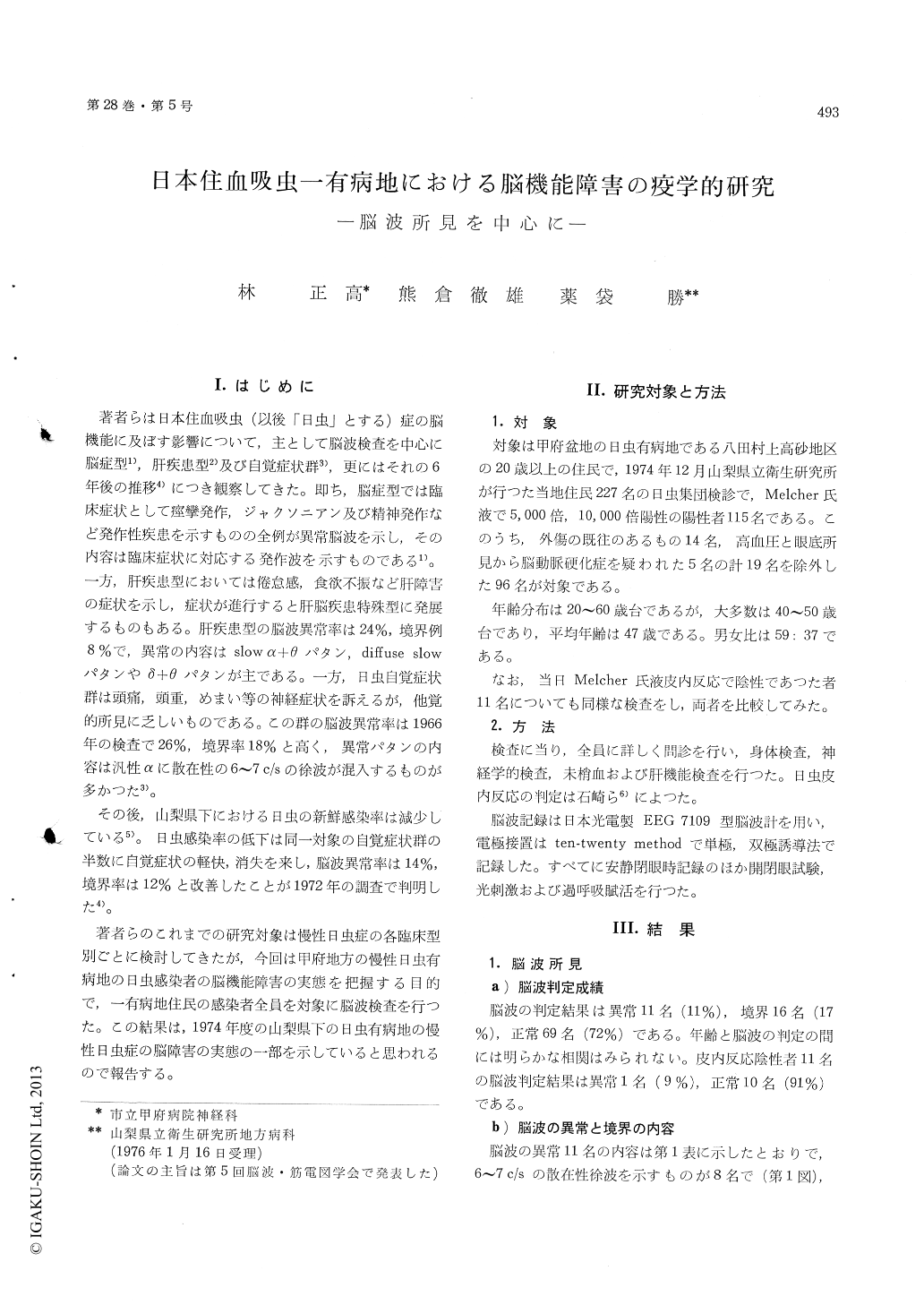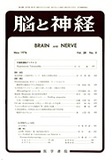Japanese
English
- 有料閲覧
- Abstract 文献概要
- 1ページ目 Look Inside
I.はじめに
著者らは日本住血吸虫(以後「日虫」とする)症の脳幾能に及ぼす影響について,主として脳波検査を中心に脳症型1),肝疾患型2)及び自覚症状群3),更にはそれの6年後の推移4)につき観察してきた。即ち,脳症型では臨宋症状として痙攣発作,ジャクソニアン及び精神発作など発作性疾患を示すものの全例が異常脳波を示し,その内容は臨床症状に対応する発作波を示すものである1)。一方,肝疾患型においては倦怠感,食欲不振など肝障害の症状を示し,症状が進行すると肝脳疾患特殊型に発展するものもある。肝疾患型の脳波異常率は24%,境界例8%で,異常の内容はslow α+θパタン,diffuse slowパタンやδ+θパタンが主である。一方,日虫自覚症状群は頭痛,頭重,めまい等の神経症状を訴えるが,他覚的所見に乏しいものである。この群の脳波異常率は1966年の検査で26%,境界率18%と高く,異常パタンの内容は汎性αに散在性の6〜7c/sの徐波が混入するものが多かつた3)。
その後,山梨県下における日虫の新鮮感染率は減少している5)。日虫感染率の低下は同一対象の自覚症状群の半数に自覚症状の軽快,消失を来し,脳波異常率は14%,境界率は12%と改善したことが1972年の調査で判明した4)。
The types of chronic schistosomiasis japonica areclassified into the following forms by the clinicalsymptoms: 1) form with only subjective symptom(such as fatigue, mild headache and dizziness), 2)hepatic form (including portal systemic encephalo-pathy), 3) cerebral form (showing various symptomssuch as generalized convulsion, partial convulsion,psychic seizure and symptom like the brain tumor).
The anthers already reported the studies of e-lectroencephalographic (EEGic) findings on eachforms. According of our results, the frequency ofabnormal EEGs of the cerebral form revealed almost100%, and they showed remarkably abnormal suchas slow wave burst or epileptic discharges.
In the observation of 100 patients with hepaticform, abnormal EEGs were obtained in 32 cases(32%), showed also EEGic abnormal pattern suchas diffuse slow waves or much theta waves withsome delta waves.
On the other hand, abnormal and borderline EEGswere obtained in 31 cases (44%) of 70 patientswith only subjective symptom, and showed slightlyabnormal such as diffuse alpha pattern or patternwith random theta waves (1966).
Six years later (1972), EEGs on the same subjectsmentioned above were re-examined in regard tothe changes of the EEGs and the subjective symp-toms. The results obtained showed that the fre-quency of the abnormal EEGs decreased from 44%to 26% and that the characterlistic abnormal find-ings were greatly improved. The subjective symp-toms of these cases also disappered or improved inabout a half of them. It was very interesting thatmost of these improved cases in EEGs also showedimprovement of the subjective symptoms.
Based on these results mentioned above, a fieldsurvey for EEGs of chronic schistosomiasis japonicawere carried out of those individuals who live ina epidemic area of Kofu basin and have a pasthistory of schistosoma infection. The followingresults were obtained.
1) Abnormal EEGs were obtained in 11 of 96cases (11%), borderline in 16 cases (17%) and normalin 69 cases (72%) under resting condition. Theresults of 28% in abnormal and borderline EEGsare essentially similar to the observations in 1972.
2) Most of the abnormal EEGs showed diffusealpha waves, slow wave bursts were activated bythe hyperventilation. Borderline EEGs showed fastwaves with much intermediate fast waves, highamplitude basic rhythm and diffuse 8-9cps alphawaves.
3) There was significant difference in the oc-currence of abnormal EEGs in the cases withthrombocytopenia and leukopenia, and no differencein the cases with liver-hypofunction.
4) The cases with subjective symptoms such asheadache, dizziness and fatigue showed high ab-normal frequency of EEGs in 50%.

Copyright © 1976, Igaku-Shoin Ltd. All rights reserved.


